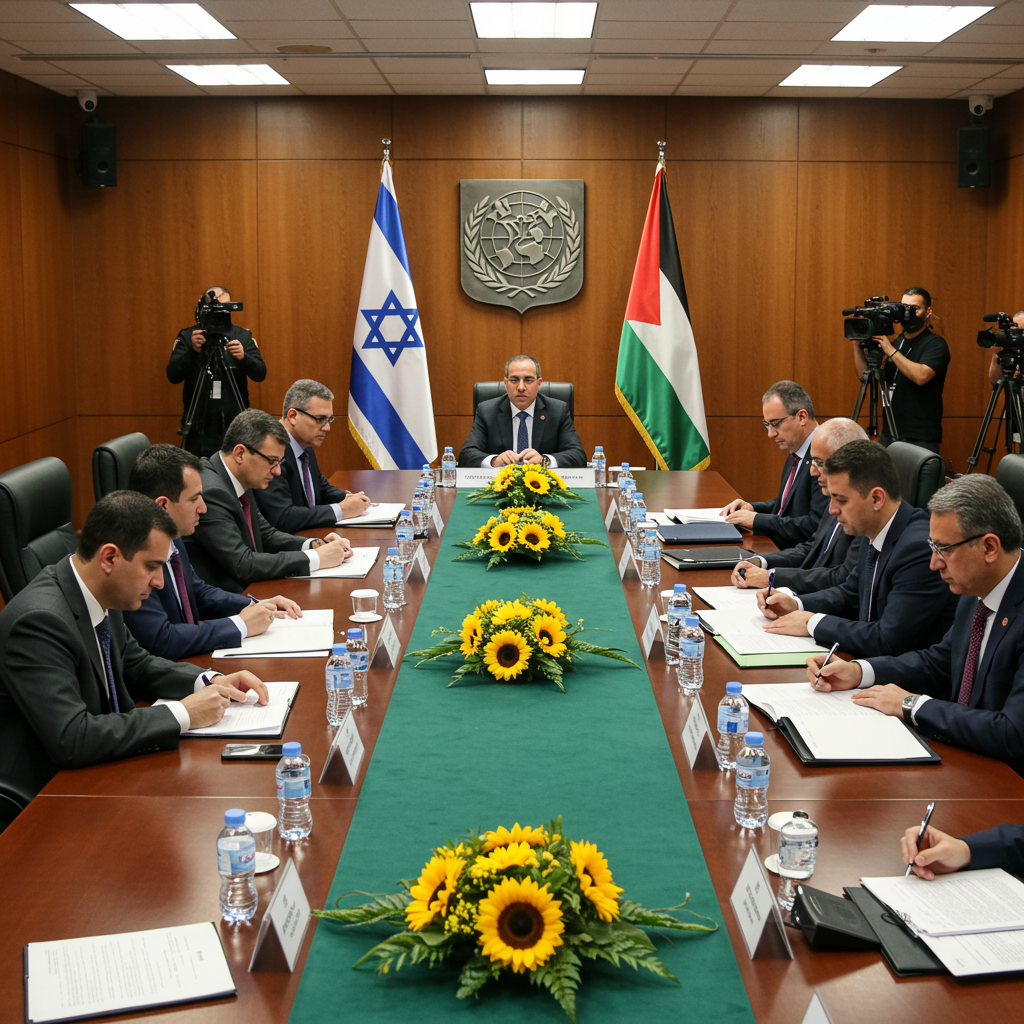As July 2025 continues, hope for an end to the brutal nearly two-year conflict in Gaza rests precariously on a new ceasefire proposal. Intensive negotiations are underway, aiming to pause the devastating hostilities that have fundamentally altered the region and resulted in the deaths of tens of thousands. Mediators urgently await a response from hamas regarding the latest framework, a decision anticipated following internal consultations. The core question revolves around whether the proposed pause offers sufficient guarantees to genuinely pave the way for a permanent peace, a central demand from Hamas leadership.
A Decisive Moment for Gaza
The current diplomatic efforts represent a critical juncture after months of intense, yet ultimately unsuccessful, talks earlier in 2025. The international community, including the United States, Egypt, and Qatar, had previously brokered a phased agreement that briefly offered respite. This earlier deal, initiated in January 2025, included temporary halts in fighting and saw the exchange of dozens of israeli hostages for hundreds of Palestinian prisoners. It also facilitated an increase in vital humanitarian aid reaching Gaza and permitted some displaced Palestinians to return to designated areas.
Echoes of Past Failures
However, that initial truce faltered by March 2025, collapsing primarily during the planned transition period between its phases. Insurmountable sticking points proved decisive. Hamas leaders publicly stated they would not agree to extend the first phase without firm commitments to negotiate the second phase, which explicitly demanded the complete withdrawal of Israeli forces from Gaza and a definitive end to the war.
Previous proposals mapped out a path involving the release of remaining hostages, including soldiers and other male captives, in exchange for a larger contingent of Palestinian detainees and a full Israeli pullout. Yet, Israeli Prime Minister Benjamin Netanyahu consistently reiterated his non-negotiable dual objectives: securing the release of all hostages and ensuring the destruction of Hamas’s military and governance capabilities. This latter goal, particularly the refusal to fully withdraw or allow Hamas to retain any significant power, directly clashed with Hamas’s prerequisite of a permanent cessation of hostilities for releasing remaining captives.
Adding complexity were specific contentious issues, such as the presence of Israeli forces in the strategic Philadelphi Corridor along the Gaza-Egypt border. Israel maintained its position there, citing the necessity to prevent Hamas rearming through smuggling tunnels, a stance that directly contradicted terms expected in later phases of the earlier agreement. Furthermore, political pressures within Israel, especially from Netanyahu’s hard-line coalition partners vehemently opposing any deal that didn’t guarantee Hamas’s annihilation, significantly constrained the government’s flexibility and willingness to adhere to previous ceasefire frameworks.
The Core Stalemate: Two Irreconcilable Goals
The fundamental disagreement over the ultimate outcome of the conflict remains the primary obstacle. Hamas seeks concrete guarantees for an end to the fighting, a full Israeli withdrawal, and potentially a commitment towards Palestinian statehood. While signaling a willingness to potentially yield political authority in Gaza to a unity government, Hamas insists on retaining its military capabilities until an independent state is achieved. This contrasts sharply with Prime Minister Netanyahu’s unwavering commitment to dismantling Hamas entirely, a goal many experts believe is difficult to achieve solely through military means and creates significant challenges for any viable post-war governance plan in Gaza.
The absence of a clear, mutually agreed-upon plan for who will govern Gaza after the conflict ends is a major impediment to achieving a lasting deal. Without an acceptable alternative authority recognized by both sides and the international community, the prospect of a permanent ceasefire is complicated by concerns about a potential power vacuum or Hamas’s potential resurgence. International mediators continue working intensely behind the scenes, striving to bridge the substantial gap between the parties’ demands and visions for the future of the strip.
A New Proposal on the Table
The latest proposal, currently under review by Hamas in July 2025, reportedly outlines a potentially revised path forward. It likely builds upon elements from earlier failed attempts but incorporates adjusted terms aimed at making it more palatable. Crucially, from Hamas’s perspective, this plan must offer assurances that negotiations following an initial temporary pause will genuinely lead to a lasting conclusion to the nearly two-year conflict. Palestinian political analysts observe that Hamas remains primarily focused on achieving a comprehensive cessation of hostilities, prioritizing this over merely a temporary reprieve from fighting. Sources suggest this new framework includes a potential 60-day truce period, championed by US and Qatari mediators.
The Unseen Cost: Gaza’s Humanitarian Catastrophe
Meanwhile, the civilian population in Gaza, living under constant threat, endures an extreme humanitarian crisis. After almost two years of war, vast areas of the territory lie in ruins, and over 90% of the population remains displaced. Residents face acute shortages of food, clean water, healthcare, and basic necessities daily. The sheer scale of destruction suggests rebuilding efforts could take decades, starkly underscoring the desperate and urgent need for a permanent end to the violence and blockade.
Investing in Uncertainty? Market Impacts
The precarious situation in Gaza also carries significant implications for regional stability and financial markets. According to analysis from ainvest.com, the current ceasefire talks represent a “volatile crossroads” for Middle Eastern markets. While a successful truce could ease geopolitical risks and encourage investment, significant risks remain. Hamas’s insistence on retaining its arms is viewed as a critical risk undermining trust. Furthermore, the credibility and capacity of US enforcement, particularly under President Trump amid domestic political distractions, are cited as potential hurdles.
The success or failure of negotiations could dramatically affect energy markets. A truce might ease fears of supply disruptions, including in critical areas like the Strait of Hormuz, potentially stabilizing oil prices. Conversely, renewed conflict could push Brent crude prices above $90 per barrel. While reconstruction in Gaza presents a massive potential investment opportunity, estimated potentially over $100 billion, analysts strongly caution against rushing into related bonds. Past issues with aid delivery transparency suggest avoiding Gaza-specific investments until Hamas softens its stance and aid flows become reliable. Instead, focusing on regional stability through partnerships with countries like Jordan and Egypt, potentially via infrastructure projects like upgrading Jordan’s Aqaba port, is recommended as a safer approach. Israeli cybersecurity and defense tech firms may also see sustained demand regardless of the ceasefire outcome.
Israel’s Internal Divide and US Influence
Israeli Prime Minister Benjamin Netanyahu finds himself at a strategic “crossroads” as he navigates the situation, facing pressure from the US administration, which reportedly seeks a ceasefire soon. While the military leadership has suggested exploring a diplomatic path after significantly degrading Hamas, far-right factions within Netanyahu’s coalition vehemently oppose any deal that doesn’t achieve Hamas’s total destruction, demanding a forceful approach.
Sources suggest Netanyahu’s approach may be aligning with perceived US goals under President Trump, potentially shifting towards more localized hostage-rescue operations within Gaza. Experts like Col. (ret.) Amit Assa believe Israel’s strategy is being coordinated closely with Washington. This contrasts with some, like former NSA Meir Ben Shabbat, who emphasize that a comprehensive deal based on Hamas’s demands would inevitably mean allowing the group, though damaged, to survive and potentially reconstitute itself using its tunnel network, overseas leadership, and control over aid. For many Israelis, particularly families of the remaining hostages, the paramount importance is securing the release of their loved ones, even if it requires difficult concessions. This internal debate highlights the profound challenge facing Israel’s leadership.
The Hostage Crisis and Public Pressure
For families on both sides, the extended negotiations and uncertain outcomes inflict immense psychological strain. Israelis holding onto hope for the return of approximately 50 remaining hostages face agonizing uncertainty, fearing for their lives. The plight of those still held in Gaza remains a powerful emotional factor driving public and political pressure in Israel. Simultaneously, Palestinians in Gaza endure unimaginable suffering amidst widespread destruction, displacement, and constant fear of renewed hostilities, longing for an end to the violence that has upended their lives. The precariousness of the situation underscores that even a temporary truce won’t solve the underlying issues required for lasting stability.
Frequently Asked Questions
What are the main reasons past Israel-Hamas ceasefire attempts failed?
Previous ceasefire attempts, such as the phased agreement in early 2025, collapsed primarily because they stalled during the transition phase intended to lead to a permanent end to the war. Hamas demanded guarantees for a full Israeli withdrawal from Gaza and a permanent cessation of hostilities as a condition for releasing remaining hostages, which Israel’s leadership, particularly Prime Minister Netanyahu, refused to provide due to objectives focused on dismantling Hamas. Disagreements over issues like Israeli presence along the Philadelphi Corridor and internal political pressures in Israel also contributed significantly to the breakdown.
What regional investment opportunities are considered safer than Gaza reconstruction right now?
Analysts assessing the market impact of the conflict suggest that while Gaza reconstruction presents a potential $100+ billion opportunity, it is currently high-risk due to Hamas’s stance and aid transparency issues. Safer regional investment alternatives highlighted include infrastructure projects in countries demonstrating more stability and closer alignment with the US, such as Jordan and Egypt. Specific opportunities mentioned include upgrades to Jordan’s Aqaba port. Investing in Israeli cybersecurity and defense technology firms is also seen as a potentially more secure option, as regional tensions are likely to persist.
What is the primary obstacle preventing agreement on the current ceasefire proposal?
The main obstacle is the fundamental disagreement between Hamas and Israel regarding the conflict’s endgame. Hamas insists on guaranteed negotiations leading to a permanent end to the war, a full Israeli withdrawal, and retaining its capabilities. Conversely, Israeli Prime Minister Netanyahu maintains his objective of dismantling Hamas’s capabilities and refuses to guarantee a permanent end to military operations, conflicting directly with Hamas’s core condition for releasing remaining hostages. This clash of visions for Gaza’s future prevents bridging the gap.
The Precarious Path Ahead
As Hamas considers its formal response to the latest proposal, the international community and the populations affected in Gaza and Israel remain in a state of anxious anticipation. Acceptance could potentially open the door to immensely complex negotiations on implementing a pause and conducting hostage-prisoner exchanges. Rejection, however, risks a rapid return to full-scale conflict, further exacerbating the already catastrophic humanitarian situation and prolonging the immense suffering that has characterized the past two years. The coming hours and days are critical in determining whether this new diplomatic effort can succeed where others have failed, offering a desperately needed respite and a potential turning point in the devastating conflict.
Word Count Check: 1199 words




